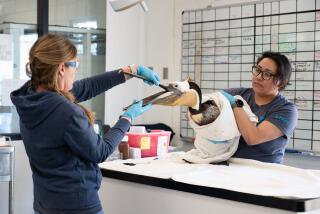Pelicans eat through bird-rescue group’s budget
- Share via
The San Pedro nonprofit group charged with treating sick pelicans is suffering an affliction of its own: strapped finances.
That’s because a cold and starving pelican eats a whopping 6 pounds of fish a day -- half its body weight.
Hundreds of brown pelicans turned up dead or ailing along the West Coast in January after what researchers said was a miscalculation: They strayed to the far northern edge of their range, stayed too long and ran out of food. When they came south, they found food scant here too.
So they turned up listless on beaches or begging for food in parking lots, and were rescued by San Pedro’s Oiled Bird Care and Education Center.
The facility is run by the International Bird Rescue Research Center, which has a $1.1-million annual budget and is one of the largest in the state’s network of groups that rescue birds affected by oil spills.
The group was able to save about two-thirds of the 435 pelicans it has treated so far at its two coastal centers, but the effort has meant shoveling out $11,000 a month for pelican all-you-can-eat seafood dinners.
“The good thing about pelicans is that they eat a lot,” said spokesman Paul Kelway. “And the tough thing about pelicans is that they eat a lot.”
Good, because ravenous pelicans recover quickly. Tough, because the cost of hundreds of pounds of frozen sardines every day at the San Pedro center has drawn down the group’s reserves.
Pelicans “are built to stuff themselves,” said Dave Jessup, a wildlife veterinarian who manages the state Fish and Game Department’s Marine Wildlife Veterinary Care and Research Center in Santa Cruz. “They eat and gorge, and sometimes they can’t fly very well for several hours.”
The International Bird Rescue Research Center was formed in the 1970s to respond to oil spills. For years, it has relied primarily on state funds, oil-spill contracts and reimbursements from polluters.
But because this year’s pelican malady was not caused by an oil spill, the organization has had to dig into its own coffers to pay for pelican care.
It has tapped the same donors repeatedly, and finally resorted to triage, Kelway said. “It’s like having 200 Labradors turn up at your house at once,” he said.
During a recent feeding at the center, the pelicans’ appetite was like a gathering cloud.
Workers approached with buckets of sardines, and the big birds came to attention, yellow heads high, eyes as big as nickels watching every move.
The workers edged into the pens. The pelicans hop-hopped closer.
A worker sloshed sardines into a tub, then ducked.
Dozens of flapping, waddling pelicans surged forward, knocking each other with huge wings and stepping on an unfortunate gull in their midst. Stretching their necks, they used long bills like chopsticks, snatching fish six at a time and tipping back their heads to gulp them.
“Ridiculous birds,” one worker muttered, watching.
In seconds, the fish were gone. A few pelicans lingered, disconsolate, staring into the empty tubs.
At the height of the pelican crisis, Kelway said, there were more than 200 birds at the San Pedro center, and people kept calling with more rescue requests.
Organizers had to tell some callers to wait. Volunteers were putting in 14-hour days, and funds were stretched thin.
This week, the calls began to wane at last, and the number of pelicans at the center dropped to 100. With time to assess, organizers are considering a new direction for bird rescues.
The pelican episode has made it clear that their efforts must expand beyond oil spill response, Kelway said.
The group has long aided injured birds. But now organizers want to establish a well-funded service for mass rescues of wildlife of all kinds, Kelway said. That means less reliance on oil spill money and more fundraising, he said.
The shift comes as other large die-offs unrelated to oil spills have increased in recent years, including those caused by algae blooms, he said. But there is another driver: public attitudes. “What was exposed here was a public expectation that someone will come take care of these animals,” Kelway said.
In some ways, bird rescue is a victim of its own success: Californians now assume when they see a sick bird that someone will care for it, he said.
For now, although pelicans have eaten through much of the bird-rescue group’s food budget for the entire year, organizers say that while their finances are spare, they are beginning to develop new sources of support.
Meanwhile, the pelicans are recovering. When released after a week or so of gluttony, they are eager to go, said Diana Pereira, an intern at the center. “Eight or nine will all fly away together,” she said. “It’s very nice.”
jill.leovy@latimes






